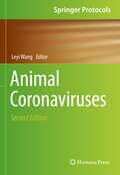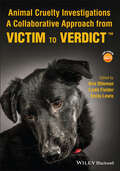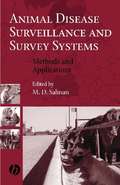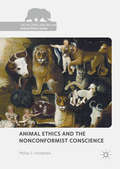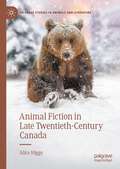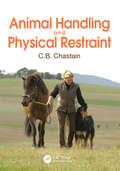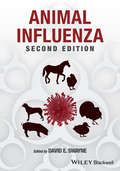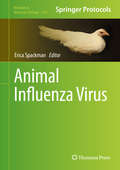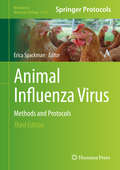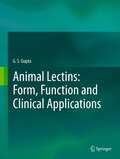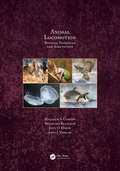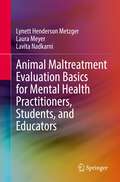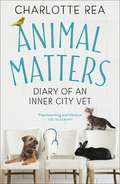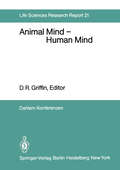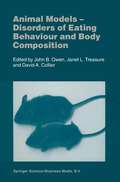- Table View
- List View
Animal Coronaviruses (Springer Protocols Handbooks)
by Leyi WangThis detailed new edition compiles fully updated practical methodologies and approaches for diagnosticians and researchers working toward a better understanding of animal coronaviruses. The book explores vital techniques in virus isolation, diagnostic approaches via the detection of viral nucleic acids or proteins, serology, disease-targeted animal species models, and next-generation sequencing and bioinformatics. Written for the invaluable Springer Protocols Handbooks series, chapters contain readily reproducible laboratory protocols as well as expert tips on troubleshooting and avoiding known pitfalls. Thorough and hands-on, Animal Coronaviruses, Second Edition will help readers design and carry out their increasingly important projects in clinical research, diagnostics, disease surveillance, and epidemiological study involving this family of viruses.
Animal Cruelty Investigations: A Collaborative Approach from Victim to Verdict
by Kris K. Otteman Brant Linda Fielder Emily LewisAnimal Cruelty Investigations: A Collaborative Approach from Victim to Verdict provides a framework for the experts who respond to animal cruelty cases: veterinarians, law enforcement agencies, animal care and control organizations, and prosecutors. This book is a practical guide which provides insight and direction for every phase of an animal cruelty investigation. The step-by-step guidance on responding to particular issues and challenges related to animal cruelty cases is bolstered by the extensive library of checklists, form templates, specific case protocols, and lists of available resources. This book is designed to empower readers to respond to animal cruelty cases confidently and effectively by: Introducing veterinarians to their critical role in animal cruelty investigations including forensic examination and necropsy, crime scene response, report writing, and testimony. Included are detailed Specific Case Protocols for common animal cruelty scenarios. Helping animal shelters navigate the challenges of holding animals in protective custody, housing unusual species, and placing evidence animals in foster care. Offering law enforcement agencies useful methods for investigating animal cruelty such as search and seizure protocols, witness interview techniques, and valuable forms and templates necessary to strengthen and ensure proper search warrant execution, evidence collection and handling, and chain of custody; all with a focus on animals as both victims and evidence. Guiding prosecutors through the steps necessary to utilize the veterinarian’s findings during trial and providing insight into issues to be considered when reviewing search warrants, filing charges, proposing plea agreements, or filing pre-conviction forfeiture motions. This book is a must-have reference and guide for veterinarians, technicians, law enforcement officers, prosecutors, and all those involved in the protection of animals’ health and wellbeing. The successful investigation of animal crimes relies on each of these disciplines, not only carrying out their professional duties, but having a collective understanding of what each other needs in order to meet that expectation.
Animal Cruelty Investigations: A Collaborative Approach from Victim to Verdict
by Kris Otteman Linda Fielder Emily LewisAnimal Cruelty Investigations: A Collaborative Approach from Victim to Verdict provides a framework for the experts who respond to animal cruelty cases: veterinarians, law enforcement agencies, animal care and control organizations, and prosecutors. This book is a practical guide which provides insight and direction for every phase of an animal cruelty investigation. The step-by-step guidance on responding to particular issues and challenges related to animal cruelty cases is bolstered by the extensive library of checklists, form templates, specific case protocols, and lists of available resources. This book is designed to empower readers to respond to animal cruelty cases confidently and effectively by: Introducing veterinarians to their critical role in animal cruelty investigations including forensic examination and necropsy, crime scene response, report writing, and testimony. Included are detailed Specific Case Protocols for common animal cruelty scenarios. Helping animal shelters navigate the challenges of holding animals in protective custody, housing unusual species, and placing evidence animals in foster care. Offering law enforcement agencies useful methods for investigating animal cruelty such as search and seizure protocols, witness interview techniques, and valuable forms and templates necessary to strengthen and ensure proper search warrant execution, evidence collection and handling, and chain of custody; all with a focus on animals as both victims and evidence. Guiding prosecutors through the steps necessary to utilize the veterinarian’s findings during trial and providing insight into issues to be considered when reviewing search warrants, filing charges, proposing plea agreements, or filing pre-conviction forfeiture motions. This book is a must-have reference and guide for veterinarians, technicians, law enforcement officers, prosecutors, and all those involved in the protection of animals’ health and wellbeing. The successful investigation of animal crimes relies on each of these disciplines, not only carrying out their professional duties, but having a collective understanding of what each other needs in order to meet that expectation.
Animal Disease Surveillance and Survey Systems: Methods and Applications
by M. D. SalmanThis valuable text presents methods and techniques for conducting an animal disease surveillance program, and developing an animal health moitoring system. The text is a 'recipe book' for these techniques as it explains modern techniques, while emphasizing the fundamentals and principles of using these techniques.The book is targeted to epidemiologists and other animal health authorities who are working in national, regional, and international programs. The book can be used as a text for professional and postgraduate training curricula. This text will be of value in veterinary epidemiology and regulatory medicine, where there is need for a concise collection of material on animal disease monitoring, surveillance, and reporting strategies. This need arises from a new era of international trade regulations based on animal diseases, new demands for accountability in utilization of research funds, and calls for prioritizing and economically justifying animal health regulatory and diagnostic activities.
Animal Endo-SiRNAs: Methods and Protocols (Methods in Molecular Biology #1173)
by Andreas WernerAnimal Endo-SiRNAs: Methods and Protocols presents a variety of approaches to investigate endo-siRNAs. These include protocols applicable to study short RNAs expressed at a low level and model systems that are particularly suitable to investigate specific aspects of endo-siRNAs, their synthesis, their genomics or regulatory role. Written in the highly successful Methods in Molecular Biology series format, chapters include introductions to their respective topics, lists of the necessary materials and reagents, step-by-step, readily reproducible laboratory protocols and tips on troubleshooting and avoiding known pitfalls.Authoritative and practical, Animal Endo-SiRNAs: Methods and Protocols contains practical tips that are absent in standard lab manuals.
Animal Ethics and the Nonconformist Conscience (The Palgrave Macmillan Animal Ethics Series)
by Philip J. SampsonThis book explores the religious language of Nonconformity used in ethical debates about animals. It uncovers a rich stream of innovative discourse from the Puritans of the seventeenth century, through the Clapham Sect and Evangelical Revival, to the nineteenth century debates about vivisection. This discourse contributed to law reform and the foundation of the RSPCA, and continues to flavour the way we talk about animal welfare and animal rights today. Shaped by the "nonconformist conscience", it has been largely overlooked. The more common perception is that Christian “dominion” authorises the human exploitation of animals, while Enlightenment humanism and Darwinian thought are seen as drawing humans and animals together in one "family". This book challenges that perception, and proposes an alternative perspective. Through exploring the shaping of animal advocacy discourses by Biblical themes of creation, fall and restoration, this book reveals the continuing importance of the nonconformist conscience as a source to enrich animal ethics today. It will appeal to the animal studies community, theologians and early modern historians.
Animal Fiction in Late Twentieth-Century Canada (Palgrave Studies in Animals and Literature)
by Alice HiggsAnimal Fiction in Late Twentieth-Century Canada fulfils a vital contribution to the conversation surrounding animal representation as a point of continuity in national narratives and supports the idea that focusing on narratives of responsibility and care influences better relations with both non-human animals and across settler-Indigenous boundaries. Alice Higgs engages with on-going debates regarding reconciliation by demonstrating that it is imperative to critique settler colonial environmental frameworks and place autonomy back into Indigenous communities by bringing Indigenous practices of custodianship and relationality to bear more generally. This book also develops a number of conversations in animal studies in relation to the politics of representation. Higgs studies a range of canonical Canadian authors, demonstrating a progress across the period in which it is possible to identify the emergence of a literary pro-animal turn.
Animal Handling and Physical Restraint
by C. B. ChastainKey features: Stresses safety in handling, restraint, and containment of animals Covers handling and restraint of all domestic and common tamed animals and provides information on normal animal behavior and welfare Discusses how to recognize signs in animals of poor handling and containment Reviews zoonotic disease risks to animal handlers, particularly from normal-appearing animals, and how to avoid transmission of disease Features over 200 informative line drawings for clarity and simplicity of illustration Explains how to tie useful knots and hitches and when to use them for restraint Includes basic ethical considerations and legal liabilities of animal handling and containment Presents steps to prevent animal escapes, barn fires, and problems with transport Authored by an experienced veterinary educator in clinical medicine for veterinarians, veterinary students, pre-veterinary students, veterinary technicians and technologists, animal scientists, and animal owners Proper handling and restraint are essential to the welfare of captive animals, allowing them to be examined, groomed and treated in ways that contribute to their optimum quantity and quality of life. The aim of the book is to prepare future or current veterinarians and veterinary technologists, technicians/nurses, and assistants to be able to handle animals more safely and gain the confidence of animals and their owners. In turn, they will be able to instruct owners in proper animal handling methods, reducing the risk of physical injury or mutual infectious diseases. Throughout the book, the author emphasises that each animal is an individual and each handling environment provides its own advantages and disadvantages: handling an animal safely, humanely and efficiently requires practical knowledge of the species’ normal behaviour. This is explored in detail in each of the species-based chapters, which cover proper handling of domestic household and laboratory animals, as well as farm and ranch animals where safe handling aids the producer in both humane practice and greater profitability. After reading this book, the practitioner or student will be versed in the most basic part of the art of veterinary medicine: the safe handling of animals.
Animal Handling and Physical Restraint
by C. B. ChastainKey features: Stresses safety in handling, restraint, and containment of animals Covers handling and restraint of all domestic and common tamed animals and provides information on normal animal behavior and welfare Discusses how to recognize signs in animals of poor handling and containment Reviews zoonotic disease risks to animal handlers, particularly from normal-appearing animals, and how to avoid transmission of disease Features over 200 informative line drawings for clarity and simplicity of illustration Explains how to tie useful knots and hitches and when to use them for restraint Includes basic ethical considerations and legal liabilities of animal handling and containment Presents steps to prevent animal escapes, barn fires, and problems with transport Authored by an experienced veterinary educator in clinical medicine for veterinarians, veterinary students, pre-veterinary students, veterinary technicians and technologists, animal scientists, and animal owners Proper handling and restraint are essential to the welfare of captive animals, allowing them to be examined, groomed and treated in ways that contribute to their optimum quantity and quality of life. The aim of the book is to prepare future or current veterinarians and veterinary technologists, technicians/nurses, and assistants to be able to handle animals more safely and gain the confidence of animals and their owners. In turn, they will be able to instruct owners in proper animal handling methods, reducing the risk of physical injury or mutual infectious diseases. Throughout the book, the author emphasises that each animal is an individual and each handling environment provides its own advantages and disadvantages: handling an animal safely, humanely and efficiently requires practical knowledge of the species’ normal behaviour. This is explored in detail in each of the species-based chapters, which cover proper handling of domestic household and laboratory animals, as well as farm and ranch animals where safe handling aids the producer in both humane practice and greater profitability. After reading this book, the practitioner or student will be versed in the most basic part of the art of veterinary medicine: the safe handling of animals.
Animal Hospice and Palliative Medicine for the House Call Vet - E-Book
by Lynn HendrixGain the understanding you need to provide compassionate, end-of-life pet care. Animal Hospice and Palliative Medicine for the House Call Veterinarian provides an all-in-one guide to the skills and challenges related to this growing area of veterinary care. From setting up your business and performing your first in-home consultation to managing pain, performing in-home euthanasia, and providing grief support to the family, this book walks you through each step of care. Written by Dr. Lynn Hendrix, a leading expert and researcher in veterinary palliative medicine, this practical resource shows how to improve the quality of care for pets in the final stages of life. Comprehensive coverage addresses the essential topics of palliative care, hospice, and euthanasia. Key topics range from setting up a mobile business, in-home consultations to pain management, complementary medicine, physical support for the pet, and much more. Information on the diseases commonly seen at the end of life includes disease progression and trajectories. Single-source review covers animal end-of-life care and consulting, specifically through mobile veterinary services. 100 full-color clinical photos depict the concepts and procedures of animal palliative care. Practical insights are provided in the areas of family grief support, compassion fatigue, managing difficult home visits, and dispelling the myths of animal hospice and euthanasia. Author Lynn Hendrix is an expert veterinarian with than a decade of experience in the field of Veterinary Palliative Medicine and is also the owner/founder of Beloved Pet Mobile Vet, a company providing in-home animal hospice and euthanasia.
Animal Influenza
by David E. SwayneAnimal Influenza, Second Edition is a comprehensive text on animal influenza. Organized by species, coverage includes avian, swine, equine and mammals, with each section including data on influenza viruses, the infection and disease they cause, and strategies used in control. Covers the full range of topics within avian, swine, equine and mammalian influenzas in one comprehensive and authoritative text Provides a summarization of peer-reviewed and empirical data on influenza viruses, the infection, and diseases they cause Discusses strategies used in control of the disease Leading experts are drawn together to provide an international and multi-disciplinary perspective Fuses latest developments in basic scientific research with practical guidance on management of the disease
Animal Influenza
by David E. SwayneAnimal Influenza, Second Edition is a comprehensive text on animal influenza. Organized by species, coverage includes avian, swine, equine and mammals, with each section including data on influenza viruses, the infection and disease they cause, and strategies used in control. Covers the full range of topics within avian, swine, equine and mammalian influenzas in one comprehensive and authoritative text Provides a summarization of peer-reviewed and empirical data on influenza viruses, the infection, and diseases they cause Discusses strategies used in control of the disease Leading experts are drawn together to provide an international and multi-disciplinary perspective Fuses latest developments in basic scientific research with practical guidance on management of the disease
Animal Influenza Virus: Methods And Protocols (Methods in Molecular Biology #1161)
by Erica SpackmanAvian Influenza Virus, Second Edition aims to provide the essential methods used in working with animal influenza viruses, and to compile more advanced information that will guide the user in designing influenza studies. Influenza A viruses are among the most important pathogens for humans, food animals and companion animals. Research and diagnostics with animal influenza viruses are critical to animal health and it should be recognized that the needs and goals of animal agriculture and veterinary medicine are not always the same as those of public health. This volume sorts out the differences in the structure of the poultry, swine and equine industries, the biological differences of influenza virus from each animal group, and provides host, strain and lineage specific guidance and procedures. Written in the successful Methods in Molecular Biology series format, chapters include introductions to their respective topics, lists of the necessary materials and reagents, step-by-step, readily reproducible protocols, and notes on troubleshooting and avoiding known pitfalls.Authoritative and accessible, Avian Influenza Virus, Second Edition seeks to serve both professionals and novices with its well-honed methodologies in an effort to further our knowledge of these important pathogens.
Animal Influenza Virus: Methods and Protocols (Methods in Molecular Biology #2123)
by Erica SpackmanThis third edition aims to provide new and updated methods on animal influenza viruses as well as more advanced protocols that will guide the reader in designing research. Chapters detail influenza in peridomestic animals, marine mammals, savian influenza, swine influenza, equine influenza, hemagglutination, genome sequencing, and influenza in other mammals. Written in the highly successful Methods in Molecular Biology series format, chapters include introductions to their respective topics, lists of the necessary materials and reagents, step-by-step, readily reproducible laboratory protocols, and tips on troubleshooting and avoiding known pitfalls. Authoritative and cutting-edge, Animal Influenza Virus: Methods and Protocols, Third Edition aims to ensure successful results in the further study of this vital field.
Animal Lectins: Form, Function and Clinical Applications
by G. S. GuptaAnimal Lectins: Form, Function and Clinical Applications presents up-to-date knowledge of animal lectins. Detailed descriptions on biological activities, tissue and/or subcellular distribution, molecular structure, gene organization, possible functions, clinical applications, lectin-ligand interactions and their intervention for therapeutic purposes are provided. The recently discovered C-type lectins as well as further novel super-families of this group of molecules are described in detail. Furthermore, the clinical significance of animal lectins in inflammatory diseases, defects of immune defense and autoimmunity are described and their application as drugs and therapeutic targets is discussed. With the increasing interest in lectins in biomedical research and their therapeutic applications, this book on animal lectins and associated proteins is a must have for researchers in the area.
Animal Locomotion: Physical Principles and Adaptations
by Malcolm S. Gordon Reinhard Blickhan John O. Dabiri John J. VidelerAnimal Locomotion: Physical Principles and Adaptations is a professional-level, state of the art review and reference summarizing the current understanding of macroscopic metazoan animal movement. The comparative biophysics, biomechanics and bioengineering of swimming, flying and terrestrial locomotion are placed in contemporary frameworks of biodiversity, evolutionary process, and modern research methods, including mathematical analysis. The intended primary audience is advanced-level students and researchers primarily interested in and trained in mathematics, physical sciences and engineering. Although not encyclopedic in its coverage, anyone interested in organismal biology, functional morphology, organ systems and ecological physiology, physiological ecology, molecular biology, molecular genetics and systems biology should find this book useful.
Animal Locomotion: Physical Principles and Adaptations
by Malcolm S. Gordon Reinhard Blickhan John O. Dabiri John J. VidelerAnimal Locomotion: Physical Principles and Adaptations is a professional-level, state of the art review and reference summarizing the current understanding of macroscopic metazoan animal movement. The comparative biophysics, biomechanics and bioengineering of swimming, flying and terrestrial locomotion are placed in contemporary frameworks of biodiversity, evolutionary process, and modern research methods, including mathematical analysis. The intended primary audience is advanced-level students and researchers primarily interested in and trained in mathematics, physical sciences and engineering. Although not encyclopedic in its coverage, anyone interested in organismal biology, functional morphology, organ systems and ecological physiology, physiological ecology, molecular biology, molecular genetics and systems biology should find this book useful.
Animal Maltreatment Evaluation Basics for Mental Health Practitioners, Students, and Educators
by Lynett Henderson Metzger Laura Meyer Lavita NadkarniThis book provides a brief introduction to the growing field of animal maltreatment evaluation and treatment, with a special emphasis on clinical training from a forensic psychology perspective. Geared toward mental health practitioners, students, and educators, this broad overview focuses on foundational legal concepts, applications in clinical and psycholegal settings, and emerging perspectives on effective evaluation and treatment. The authors provide practical guidance around “real world” scenarios through the use of clinical case vignettes, highlighting the complexities and need for culturally- and psychologically-informed care in these cases. Key topics include forensic animal maltreatment evaluations (or FAMEs); implications for best practices; challenges for providers, trainees, and supervisors; and future directions for the field.
Animal Matters: Diary of an Inner City Vet
by Charlotte Rea'Heartwarming and hilarious' Telegraph'With as many horrifying stories as heart-warming ones, this is a fascinating look at the year in the life of a vet at a London animal charity hospital. There are some proper belly laughs as well as some insights that will truly stick with you.' - Alexandra Heminsley, GraziaAn unusual 'dalmation', a TV star with cancer, an out of control budgie. Charlotte Rea has seen them all, and more. Animal Matters is Charlotte's diary of real-life cases written during a one year of her work as a veterinary surgeon in a 24-hour inner-city London animal charity. The diary reveals the reality of working as a vet, how it can be both emotional and amusing, one minute you can be consoling an owner on the loss of their much-loved pet, the next trying to catch an escaped budgie. Charlotte mixes deeply sad moments with amusing and unimaginable ones along with more detailed accounts and reflections back on her training and the experiences she has come up against over the decade since she graduated. Throughout the book you will get to know both the animals and the people and how close the bond between us can be. Charlotte also discusses contemporary issues in veterinary medicine such as animal euthanasia, RSPCA welfare cases, mental health issues within the veterinary profession, ethical concerns around pedigree dog breeding and the laws on dangerous dogs. Animal Matters is a moving and heartwarming book about the unconditional love between animals and humans.
Animal Migration, Navigation, and Homing: Symposium Held at the University of Tübingen August 17–20, 1977 (Proceedings in Life Sciences)
by K. Schmidt-Koenig W. T. KeetonAnimal Mind — Human Mind: Report of the Dahlem Workshop on Animal Mind — Human Mind, Berlin 1981, March 22–27 (Dahlem Workshop Report #21)
by M. Dawkins W. Kintsch H. J. Neville R. M. Seyfarth D. R. Griffin J. F. Bennett D. Dörner S. A. Hillyard B. K. Hölldobler H. S. Markl P. R. Marler D. Premackthe oleic acid on a live and wriggling sister or mother and refrain from evicting her from our hive. But does the occur rence of unintelligent behavior suffice to demonstrate the total absence of mental experience under any circumstances? Ethologists from some distant galaxy could easily discern ex amples of stupid and maladaptive behavior in our own species. But do instances of human stupidity prove that none of us is ever consciously aware of what he is dOing? No available evi dence compels us to believe that insects, or any other animals, experience any sort of consciousness, or intentionally plan any of their behavior. But neither are we compelled to believe the contrary. In areas where data are few and of limited rel evance, dogmatic negativity can easily limit what scientists even try to investigate, and thus perhaps delay or prevent im portant insights and discoveries. Many of the participants agreed that a good starting point would be to consider what we know of our own thinking, subjec tive feelings, and consciousness, and then move on to inquire whether other species experience anything similar. Such an ap proach was once considered fallaciously anthropomorphic. But it seems now to be widely if not universally recognized that this is a serious objection only if one has already assumed in advance that conscious thinking is uniquely human, and the accu sation of anthropomorphism is then merely a reiteration of the prior conviction.
Animal Models: Disorders of Eating Behaviour and Body Composition
by David A. Collier Janet L. Treasure John B. OwenThe book aims to review knowledge on the disorders of eating behaviour and body composition in some of the non-primate higher animals and to relate these to similar conditions in humans. With advances in understanding the nature of these disorders and their biological basis, it seems timely to assess what cross-species comparisons can tell us about the general underlying factors at work. This may also help to delineate what may be a general biological basis that humans share with their higher animal comrade species and what may distinguish human from non-human, particularly in a cultural context. This could help in combating better the problems of these conditions in the animal species as well as in man and in suggesting well-based preventive measures. As far as people are concerned the last two decades of the 20th century have shown a significant increase in obesity in the richer countries, particularly the USA (Table 1). Possibly associated with the obesity boom, there is an increasing awareness of other disorders of eating behaviour and body composition. These range from anorexia nervosa, at the other end of body composition to obesity, to others, such as bulimia, with more variable effects on body composition.
Animal Models for Endometriosis: Evolution, Utility and Clinical Relevance (Advances in Anatomy, Embryology and Cell Biology #232)
by Kathy L. Sharpe-TimmsThis new volume of our successful book series Advances in Anatomy, Embryology and Cell Biology focuses on the need for and use of animal models when studying endometriosis. Covering models ranging from rodents to baboons, it explores novel mechanisms involved in the pathophysiology of endometriosis. Topics range from the role of miRNAs and environmental endocrine disrupters to pain and endometriosis-associated subfertility.Estimated to affect up to 10% of women, endometriosis is a widespread and in some cases debilitating disease. While studies on the pathophysiology of the disease and the development of treatments for endometriosis-associated subfertility are called for, acquiring appropriate tissues from women with and without endometriosis in combination with physiologically relevant in vitro and in vivo laboratory models is an essential aspect. However, control subjects with similar ages, living environments and medical histories, besides endometriosis, are hard to find and attaining suitable human reproductive tissues is linked to an ongoing ethical discussion, especially when studying embryos. Laboratory models like rodent and monkey models are therefore needed to fill the research gap and support hypothesis-driven, randomized, controlled experimental design studies. In this book we highlight the latest developments and findings in endometriosis research using animal models. The book was written for scientists, physicians and medical students working in the field of reproductive science, and for women with endometriosis.
Animal Models for Human Cancer: Discovery and Development of Novel Therapeutics (Methods and Principles in Medicinal Chemistry #69)
by Raimund Mannhold Hugo Kubinyi Gerd FolkersBased on results from the past ten years, this ready reference systematically describes how to prepare, carry out, and evaluate animal studies for cancer therapies, addressing the widely recognized lack of reliable and reproducible results. Following a short historical introduction and a discussion of the ethics surrounding animal experiments, the book describes correct study design as well as the handling and housing of animals. It then goes on to describe the animal models available for different cancer types, from natural cancer models in mice and dogs to humanized animals. An evaluation of previously unpublished long-term data from the Swiss canine and feline cancer registry is also included. The final part of the book reviews the lessons learned over the last decade on how to interpret data from animal studies for improving human therapy and gives recommendations for future drug development.
Animal Models for Human Cancer: Discovery and Development of Novel Therapeutics (Methods and Principles in Medicinal Chemistry)
by Raimund Mannhold Hugo Kubinyi Gerd FolkersBased on results from the past ten years, this ready reference systematically describes how to prepare, carry out, and evaluate animal studies for cancer therapies, addressing the widely recognized lack of reliable and reproducible results. Following a short historical introduction and a discussion of the ethics surrounding animal experiments, the book describes correct study design as well as the handling and housing of animals. It then goes on to describe the animal models available for different cancer types, from natural cancer models in mice and dogs to humanized animals. An evaluation of previously unpublished long-term data from the Swiss canine and feline cancer registry is also included. The final part of the book reviews the lessons learned over the last decade on how to interpret data from animal studies for improving human therapy and gives recommendations for future drug development.
